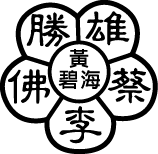

Introduction and Condensed History of Choy Lay Fut
History of Choy Lay Fut
The founder of Choy Lay Fut, Master Chan Huang, was born in July 10, 1805 in Gain Mui village of the Sun Whu Nel Sai District, Kwantung Province.
Master Chan began his martial arts training, at the age of seven, under the instruction of a distant uncle, Chan Yuen Wu. Several years later, he proceeded to continue his studies from a famous master of the Shaolin Li Style, Li Yau San.
Having completed his studies from Li, Master Chan was still not content with his learning. He travelled to Mount Lau Fout to become a disciple of a renowned Shaolin priest, Choy Fook, and started his training in the Choy Style.
After dedicating more than a decade to the master of the Choy Style, Chan bid farewell to his instructor. On his return journey through the Nan Hung District, he was enlightened with news of an acclaimed talented martial artist, a Shaolin monk named Ching Tso, and decided to further enhance his studies under Ching where he learned the Fut Style.
Master Chan complied his decades of studies in martial arts and integrated the different kung-fu styles into one unified kung fu system. He named his newly developed kung fu style Choy Lay Fut in recognition and appreciation of the teachings from his three celebrated masters.

A prose written by the Choy Lay Fut founder:
The Inception of Choy Lay Fut was self conceived,
A true descendant arose from the Shaolin origin.
Code of Ethics
All Choy Lay Fut disciples shall observe the following:
The Prime Objective
The prime objective for martial arts training is to promote physical fitness of the body and enhance spiritual well-being of the mind; the martial arts practitioner shall not exploit his/her skills to provoke violence.
Moral Values
The martial arts practitioner shall uphold righteous moral values and adhere to law and order.
Martial Arts Disciplines
The martial arts practitioner shall exercise courteous discretion and shall not indiscriminately criticize the strengths and weaknesses of martial arts from a different discipline.
Respect
The martial arts practitioner shall respect his/her instructor and value the martial arts teachings.
